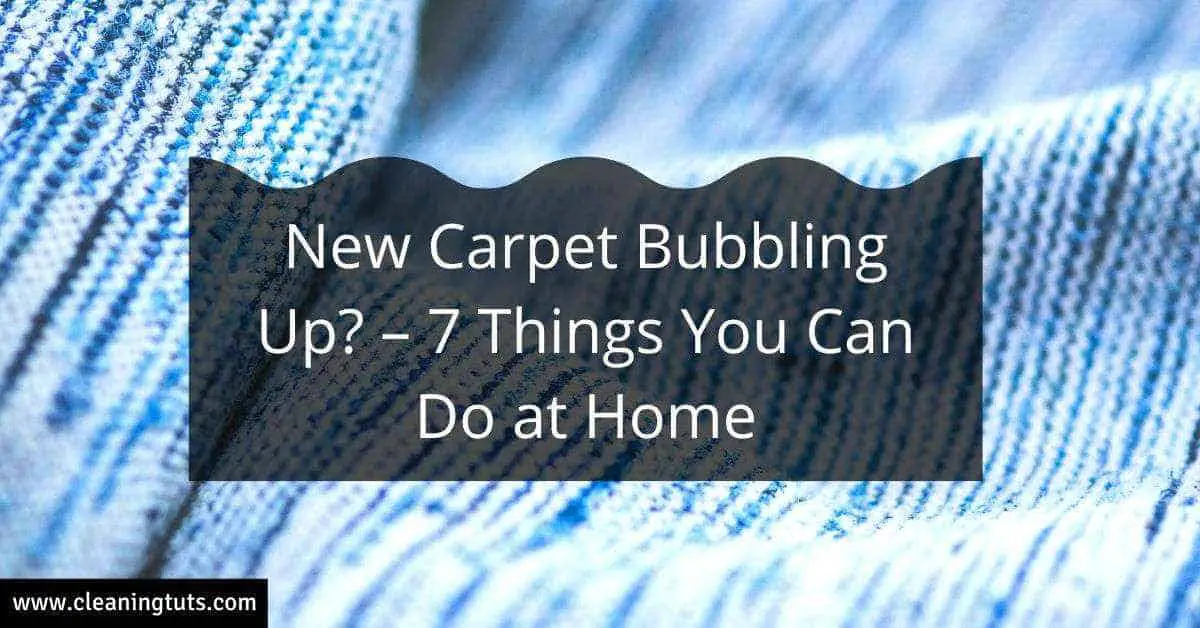New Carpet Bubbling Up? – 7 Things You Can Do at Home
Sometimes when you get a new carpet installed, it starts to bubble up. Don’t worry – you’re not alone. This is a common problem with carpets, but it’s easy to fix.
Bubbling carpets can be a result of many things, the most common being installation errors. Other reasons include using low-quality carpet pads and having unsealed seams in the flooring.
There’re quite a few reasons your new carpet is bubbling up, but there are ways to fix it. In this article, we’ll discuss the causes of bubbling carpets and offer some solutions to keep your flooring looking beautiful for years to come.
So please read on!
Be sure to have it fixed as soon as possible. Otherwise, you could be left with a permanent problem that will only get worse over time.
What Causes New Carpets to Bubble Up or Ripple?

Carpets can bubble up or ripple for a variety of reasons. Environmental factors, such as changes in humidity or temperature, can cause the fibers in the carpet to expand or contract, which can lead to bubbles or ripples.
“Human-made” factors, such as improper installation or excessive foot traffic, can also cause carpets to ripple.
If you are experiencing bubbles or ripples in your carpet, it is important to identify the cause and take corrective action.
Environmental Reasons
Carpet bubbles can form from environmental reasons like humidity and temperature levels. If there is too much moisture in the air, it can cause the carpet to bubble.
The same is true if the air is too dry. Temperature can also be a factor. If the room is too warm, the carpet may expand and bubble.
Nonetheless, here are a couple of reasons why your new carpet might be bubbling up:
Humidity
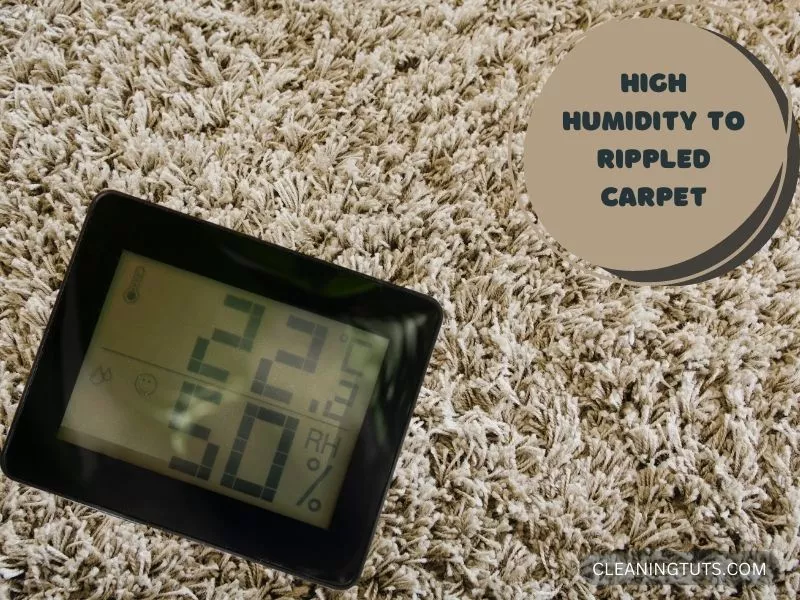
High humidity can cause your new carpet to bubble up. This happens when the carpet isn’t able to adjust to the new environment and starts to swell.
Be sure to leave enough time for the carpet to acclimate before installation and make sure that the room is at the correct humidity level before installation.
Excessive Moisture

Moisture can also cause the new carpet to bubble up. This happens when the carpet gets wet and swells.
You can prevent this by making sure that there is no water on the carpet and by using a deDehumidifier to keep the air dry and free of moisture.
Poor Ventilation
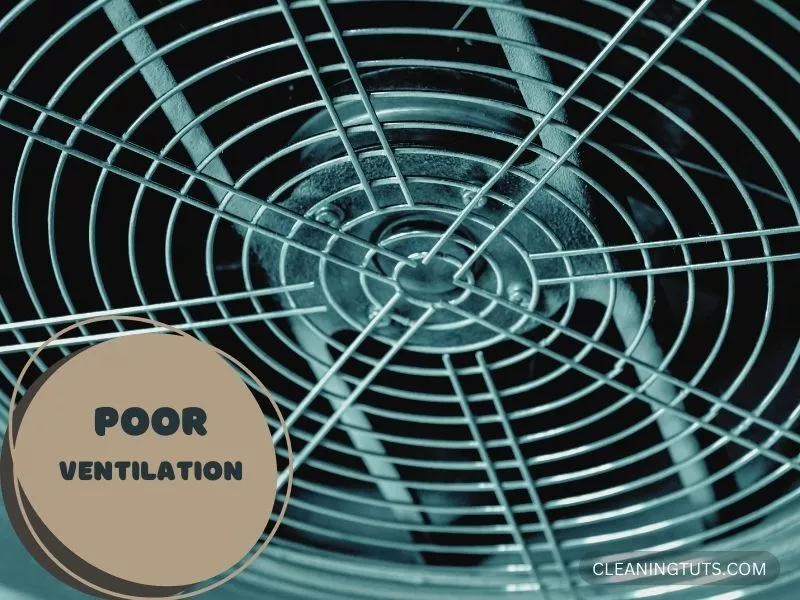
If there is not good air circulation in the room, then the carpet might start to bubble up. This is because the humidity can get trapped in the room and cause the carpet to swell.
Be sure to open windows and doors during and after installation to allow the carpet to adjust to the new environment.
Moth Larvae
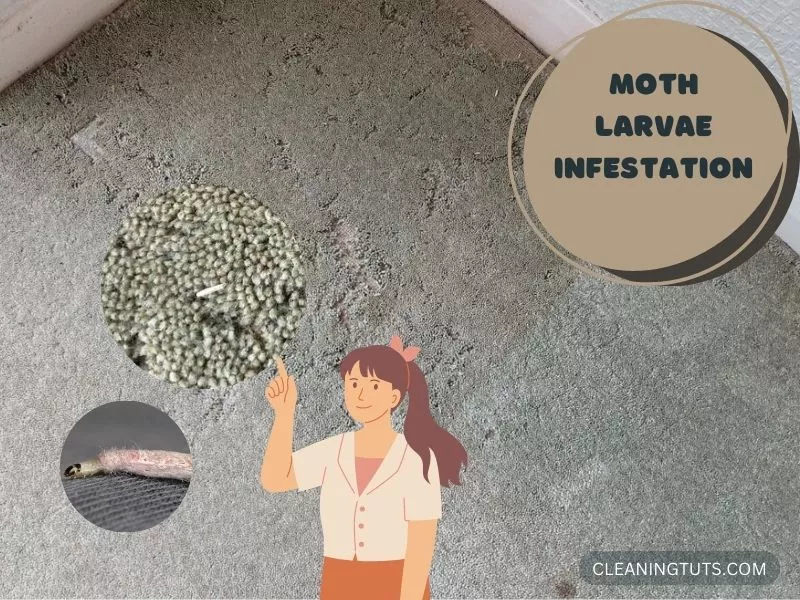
Moth larvae can also cause the new carpet to bubble up. This happens when the larvae spin their cocoons in the fibers of the carpet and cause it to swell.
You can prevent this by regularly vacuuming the carpet and keeping it free of dust and debris.
Exposure to Direct Sunlight
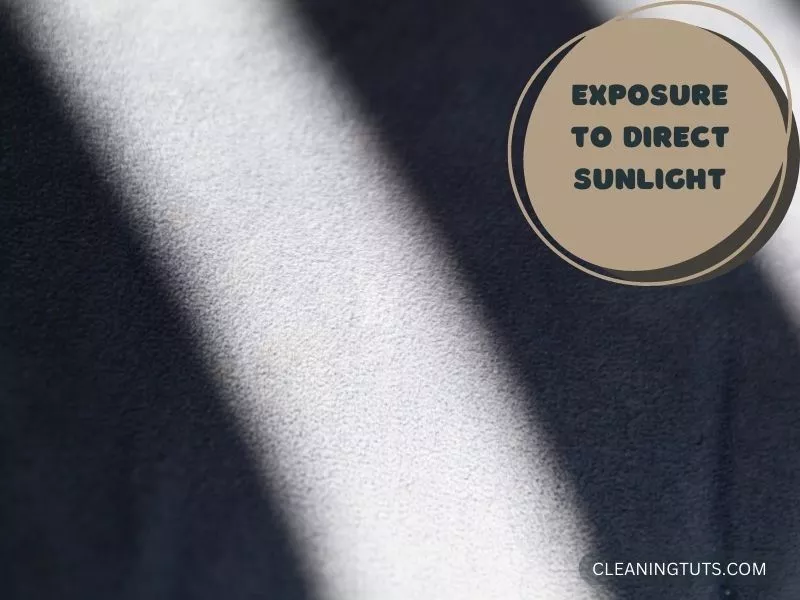
Direct sunlight can also make the carpet swell and ripple. It’s one of the environmental causes of the carpet bubbling up, so try to keep the area where your new carpet is in shaded areas as much as possible.
Human-Made Reasons
If you’re like most homeowners, you probably think that new carpet bubbling up is simply caused by moisture.
And while this is partially true, there are other Human-made factors that can contribute to the problem. Here are some of the most common man-made reasons why new carpet bubbles up:
Installation Errors

It’s alarming when your new carpet starts bubbling up soon after it’s been installed.
This is usually a sign of installation errors, and if not corrected, the problem could get worse. Some of the most common installation errors that can cause this are:
- Not allowing the carpet to acclimate to the room temperature before installation
- Not using an adequate amount of adhesive
- Not stretching the carpet tightly enough during installation
If you see any of these problems with your new carpet, it’s important to have it fixed as soon as possible. Otherwise, you could be left with a permanent problem that will only get worse over time.
Using Low-Quality Carpet Pads
When you choose to use a low-quality carpet pad, it can cause your new carpet to bubble up or ripple.
This is because the low-quality carpet pad won’t hold the carpet in place as well as a good-quality one, and the pressure of people walking on the carpet will cause it to move and ripple.
So if you don’t want your new carpet to start bubbling up soon after it’s installed, be sure to use a good quality carpet pad.
Unsealed Seams in the Flooring
If your new carpet starts bubbling up soon after it’s installed, it might be because the seams in the flooring weren’t sealed properly.
When the seams aren’t sealed, it can cause the carpet to move and ripple, and this will cause bubbles to form. So if you don’t want your new carpet to start bubbling up, be sure to have the seams in your flooring sealed properly.
Spills and Pet Accidents

When you spill something or your pet has an accident on the new carpet, it can cause the carpet to start bubbling up. This is because the spill or accident will make the carpet wet, and when it dries, it will swell and might start to ripple.
If this happens, be sure to clean up the spill or accident as soon as possible so that it doesn’t cause any long-term damage.
Heavy Items of Furniture
Heavy furniture can cause the new carpet to bubble up. This happens when the furniture pushes down on the carpet and makes it swell.
You can prevent this by making sure that the furniture is not too heavy and that it is evenly distributed across the surface of the carpet.
Delamination
Delamination can cause a new carpet to bubble up because the top of the carpet is no longer attached to the primary backing. This can result in the carpet becoming loose and bubbling up.
When the secondary backing detaches from the primary backing, it causes the top of the carpet to move and buckle. This can be very noticeable to someone walking on the carpet, as they may feel like they are walking on bubbles.
How To Prevent Carpet Buckling and Bubbling?
1. Clean Up Spills and Accidents As Soon As They Happen

When you spill something or your pet has an accident on the new carpet, it can cause the carpet to start bubbling up. This is because the spill or accident will make the carpet wet, and when it dries, it will swell and might start to ripple.
If this happens, be sure to clean up the spill or accident as soon as possible so that it doesn’t cause any long-term damage.
To clean up a spill, use a cloth or paper towel to soak up as much of the liquid as possible. Then, use a mild detergent and water to clean up the remaining liquid.
Be sure to rinse the area thoroughly with water to make sure all of the detergents are removed and dried correctly.
To clean up a pet accident, use a cloth or paper towel to soak up as much of the urine as possible. Then, use a baking soda and water mixture to clean up the remaining urine.
Be sure to rinse the area thoroughly with water to make sure all of the baking soda is removed and dried properly, leaving no wet residues.
2. Use a Good Quality Carpet Pad
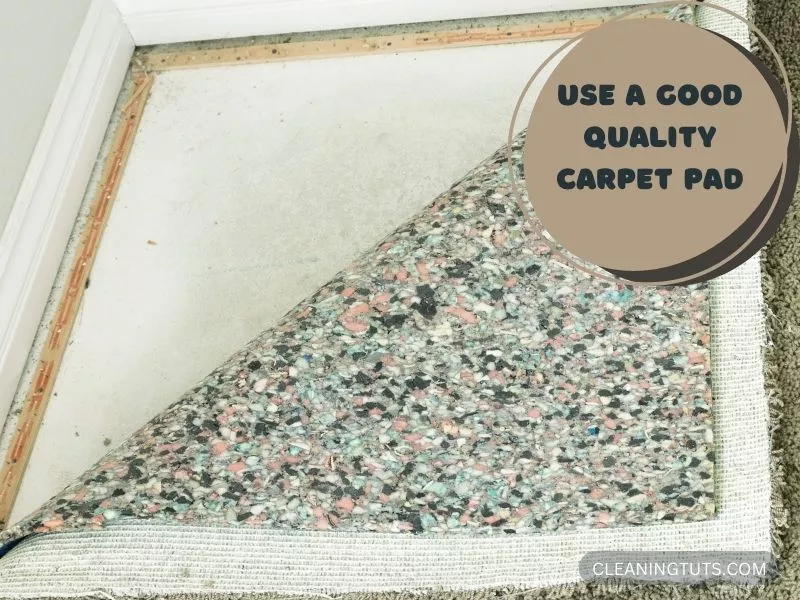
When you choose to use a good-quality carpet pad, it can help keep your new carpet from bubbling up or rippling.
A good-quality carpet pad will hold the carpet in place better than a low-quality one, and it will also help protect the carpet from spills and pet accidents.
So if you don’t want your new carpet to start bubbling up soon after it’s installed, be sure to use a good quality carpet pad.
When you’re shopping for a new carpet, be sure to ask the store associate for help. They can recommend a good quality carpet that will suit your needs and budget. Some things to look for when choosing a good quality carpet include:
The Fiber Type
Carpets made with synthetic fibers are typically more durable than those made with natural fibers.
The Density of the Fiber
The denser the fiber, the more durable the carpet will be.
The Backing
A good quality carpet will have a strong backing that won’t easily tear or rip.
The Pile Height
A higher pile height will mean that the carpet is a softer and more luxurious feeling. However, a higher pile height also means that the carpet will be more likely to show footprints and vacuum marks.
Water Resistance
If you choose a carpet that is water resistant, it will be less likely to bubble up if there is a spill or accident.
3. Seal the Seams in the Flooring

Sealing the seams in the flooring can help prevent your new carpet from bubbling up.
Seams are the areas where two pieces of flooring meet, and when they are not sealed properly, they can become a point of weakness. This is where the carpet can start to buckle and ripple.
To seal the seams in the flooring, you will need to use a seam sealant. This is a specialized sealant that is made specifically for flooring seams. It will help fill in any gaps between the two pieces of flooring and will create a watertight barrier.
When you’re choosing a seam sealant, be sure to get one that is designed for your type of flooring. There are many different types of seam sealants available, so be sure to ask your local hardware store associate for help.
Once you have chosen the right seam sealant, follow these steps to apply it:
- Clean the area where the seam will be sealed with mild detergent and water. Be sure to rinse it thoroughly and dry it completely.
- Cut the nozzle off of the seam sealant tube and insert it into the caulking gun.
- Apply a thin line of sealant along the entire length of the seam.
- Use your finger or a blunt object (like a screwdriver) to press down on the sealant and smooth it out evenly.
- Let the sealant dry completely before walking on it or moving any furniture over it
4. Make Sure the Furniture Is Not Too Heavy
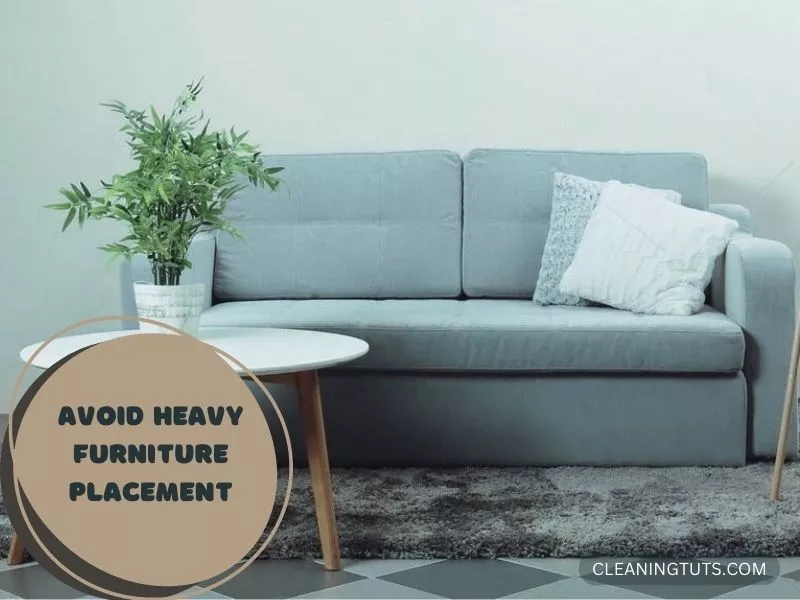
When you’re choosing furniture to place in your new home, be sure to consider the weight of the pieces. Furniture that is too heavy can put unnecessary stress on the flooring and can cause it to buckle and ripple.
If you have heavy furniture that you want to place in your home, try to limit the amount of weight that is being placed on any one area. You can do this by spacing out the furniture evenly or by using furniture pads.
Furniture pads are rubber or foam inserts that can be placed between the furniture and the flooring to help protect the flooring from scratches and damage.
Another option is to use rugs. Rugs can help soften the impact of heavy furniture and can also help protect the flooring from dirt and spills.
If you choose a rug that is large enough, it can also act as a buffer between different pieces of furniture.
5. Don’t Let the New Carpet Come into Direct Contact with Sunlight
One of the best ways to prevent your new carpet from bubbling up is to avoid exposing it to direct sunlight. Sunlight can cause the carpet to fade and can also make it more susceptible to mold and mildew.
If you can’t avoid having the carpet exposed to sunlight, try to limit the amount of time that it is in direct sunlight. You can do this by using window treatments like blinds or curtains.
Another option is to choose a carpet that is designed for outdoor use. These carpets are made with UV protection and are resistant to fading and staining.
6. Use a De-Dehumidifier
If you live in a dry climate, using a Dehumidifier can be a great way to help prevent your new carpet from bubbling up.
A Dehumidifier adds moisture to the air and can help keep the humidity level in your home between 30 and 50 percent.
When choosing a Dehumidifier, be sure to get one that is designed for indoor use. There are many different types of Dehumidifiers available, so be sure to select one that is right for your needs.
The best way to use a Dehumidifier is to place it in the room where the carpet is located.
This will help ensure that the entire room is evenly humidified. You may also want to consider using a portable Dehumidifier if you have multiple rooms with new carpets.
Pro Tip: If you are using a central Dehumidifier, be sure to clean it regularly to prevent bacteria and mold from growing.
7. Get Your Carpets Professionally Installed
When you’re installing new carpets in your home, it is always best to have a professional do it. Professionals have the experience and expertise to get the job done properly and efficiently.
If you decide to hire a professional installer, be sure to ask for references and do your research beforehand. Not all installers are created equal, so it is important to find one that has a good reputation and that you can trust.
Once you have found a qualified installer, be sure to discuss your needs and expectations with them. They should be able to give you a detailed estimate of the cost and timeline for the project.
After the installation is complete, be sure to inspect the work carefully. If you notice any problems or issues, don’t hesitate to contact the installer right away
Tips for Maintaining Your New Carpet
If you want to keep your new carpet looking its best for as long as possible, there are a few things that you can do. Here are some tips for maintaining your new carpet:
1. Vacuum Regularly
One of the best ways to keep your new carpet looking good is to vacuum it regularly. This will help remove any dirt or debris that may be tracked in or spilled on the carpet.
It is also a good idea to vacuum the edges of the carpet where it meets the walls and furniture. This will help keep these areas looking clean and neat.
2. Protect Your Carpet from Stains
One of the best ways to protect your new carpet from stains is to use a rug or mat at entrances and exits. This will help catch any dirt or debris before it has a chance to stain the carpet.
You can also use throw rugs in high-traffic areas to help protect the carpet from getting stained. If a spill does happen, these rugs can be easily cleaned up.
3. Use Furniture Pads
If you have heavy furniture that you want to place in your home, try to limit the amount of weight that is being placed on any one area. You can do this by spacing out the furniture evenly or by using furniture pads. Furniture pads are rubber or foam inserts that can be placed between the furniture and the flooring to help protect the flooring from scratches and damage.
Frequently Asked Questions
How Do You Fix Transition Frayed Carpet?
First, try gently trimming the frayed fibers with a sharp pair of scissors. If that doesn’t work, you can try applying a clear nail polish or carpet sealant to the edges of the carpet. Finally, if all else fails, you can always replace the carpet altogether.
What Is A Matted Carpet?
A matted carpet is a type of flooring that is made up of individual fibers that are knotted or looped together. This type of carpeting is often used in high-traffic areas because it is durable and can withstand a lot of wear and tear. However, matted carpeting can also be difficult to clean, so it is important to vacuum it regularly to prevent dirt and dust from building up.
How To Get Ripples Out Of Wall-to-wall Carpet
There are a few ways to get rid of ripples in wall-to-wall carpets, and the best method will depend on the severity of the issue. If the ripples are minor, you may be able to fix them with a heavy object, such as a stack of books. Place the books on top of the ripples and let them sit for a few days. The weight of the books will help to flatten the carpet. If the ripples are more severe, you may need to remove the carpet and re-stretch it.
Conclusion
Well, there you have it. Everything you ever wanted to know about why your new carpet is bubbling up and how to prevent it from happening in the future. As you can see, there are several potential causes for this pesky problem, from environmental factors to human-made reasons.
We hope you found this post helpful – now go forth and enjoy your beautiful, non-bubbly carpets! If you have any questions or comments, please feel free to share them with us below. As always, happy cleaning!

